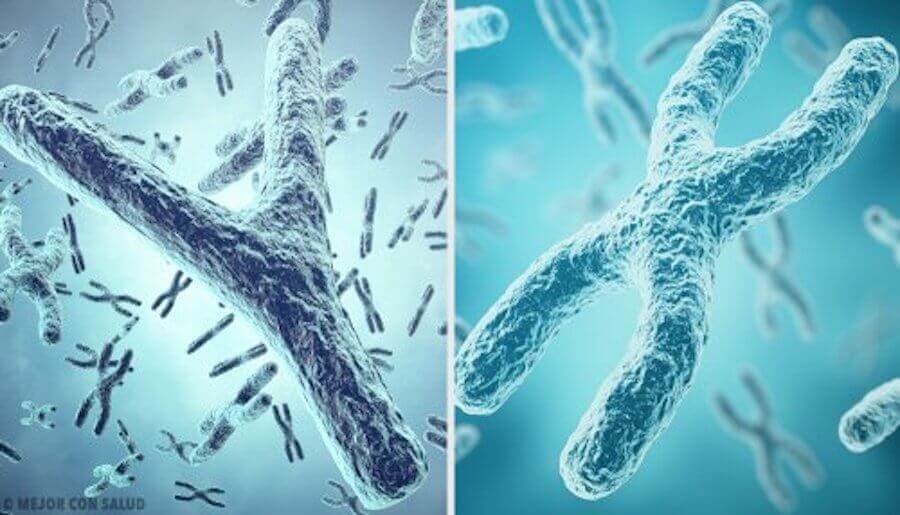Why Do I Always Have Boys?

If you’re wondering why you always have boys, today we’ll help you discover some of the determining factors that can explain this predominance.
What determines a baby’s sex?
A baby’s sex is determined by the man’s sperm during conception. The genetic information within the sperm contains the XY gametes, while the eggs of women contain XX gametes.
When they come together, women provide an X chromosome, while men provide either a X or a Y. If it’s an X chromosome, the baby will be a girl, and Y chromosome will result in a boy.

Therefore, your child’s sex depends completely on the sperm, with a 50% chance for each sex.
Why do I always have boys? Is it possible for the male sex to be more prevalent?
If there is a higher percentage of males in your family, you’re not alone. It’s becoming more and more common for families to experience same-sex births, one after another.
The scientific community in general claims this is likely due to sheer coincidence, rather than a genetic tendency.
Damaged sperm
The damages to a sperm that carries an X gamete that would lead to a baby girl may have to do with a genetic syndrome related to this sex.
This means that the embryos that come from these sperm are weak and end up not surviving.
While this is a condition that is more common among sperm that carry Y chromosomes, it can also occur in those carrying X chromosomes.
At the same time, the damage may occur directly to the X chromosomes because they’re the ones that produce the female embryo, and vice versa.
In other words, there may be an incapacity to produce the type of cell needed for a baby girl.
Physical particularities of the sperm
Some factors like the psychical characteristics of sperm, the lining of the vagina, and a woman’s fertility cycle can influence fertility significantly.
Some believe that masculine sperm are weaker, but also faster, with can favor a quick conception.
While some claim they can use this fact to decide the sex of their future baby with a 70% success rate, this isn’t completely true.
There is no scientific evidence to prove that certain foods, sexual positions, or days within the menstrual cycle have a specific effect on a baby’s sex.
Can certain external techniques predetermine a baby’s sex?
Yes, there are. In some countries, there are laws in place that allow for specific types of assisted fertility treatment. These treatments allow parents to avoid the transmission of certain hereditary illness.
There are two different techniques:
- Sperm selection. This technique allows professionals to choose the sperm that will make up the fertilized masculine or feminine cell. Therefore, they can choose the sex of the fertilized egg – thus avoiding certain genetic diseases linked to a specific sex.
- Pre-implantation analysis. This technique consists of performing in vitro fertilization and then choosing the embryos pertaining to the target sex that don’t possess the genetic illness. Then doctors proceed with implantation in the uterus.

These techniques have helped many parents not only avoid certain genetic conditions, but also choose the sex of their babies. However, these techniques aren’t permitted in every country.
The benefits of having boys
When the time comes to give birth, the most important thing is that your little one is healthy.
In conclusion, while the decision is up to the sperm, there are other possible influencing factors to why some couples always have boys, which are still being researched.
If you’re wondering why you always have boys, today we’ll help you discover some of the determining factors that can explain this predominance.
What determines a baby’s sex?
A baby’s sex is determined by the man’s sperm during conception. The genetic information within the sperm contains the XY gametes, while the eggs of women contain XX gametes.
When they come together, women provide an X chromosome, while men provide either a X or a Y. If it’s an X chromosome, the baby will be a girl, and Y chromosome will result in a boy.

Therefore, your child’s sex depends completely on the sperm, with a 50% chance for each sex.
Why do I always have boys? Is it possible for the male sex to be more prevalent?
If there is a higher percentage of males in your family, you’re not alone. It’s becoming more and more common for families to experience same-sex births, one after another.
The scientific community in general claims this is likely due to sheer coincidence, rather than a genetic tendency.
Damaged sperm
The damages to a sperm that carries an X gamete that would lead to a baby girl may have to do with a genetic syndrome related to this sex.
This means that the embryos that come from these sperm are weak and end up not surviving.
While this is a condition that is more common among sperm that carry Y chromosomes, it can also occur in those carrying X chromosomes.
At the same time, the damage may occur directly to the X chromosomes because they’re the ones that produce the female embryo, and vice versa.
In other words, there may be an incapacity to produce the type of cell needed for a baby girl.
Physical particularities of the sperm
Some factors like the psychical characteristics of sperm, the lining of the vagina, and a woman’s fertility cycle can influence fertility significantly.
Some believe that masculine sperm are weaker, but also faster, with can favor a quick conception.
While some claim they can use this fact to decide the sex of their future baby with a 70% success rate, this isn’t completely true.
There is no scientific evidence to prove that certain foods, sexual positions, or days within the menstrual cycle have a specific effect on a baby’s sex.
Can certain external techniques predetermine a baby’s sex?
Yes, there are. In some countries, there are laws in place that allow for specific types of assisted fertility treatment. These treatments allow parents to avoid the transmission of certain hereditary illness.
There are two different techniques:
- Sperm selection. This technique allows professionals to choose the sperm that will make up the fertilized masculine or feminine cell. Therefore, they can choose the sex of the fertilized egg – thus avoiding certain genetic diseases linked to a specific sex.
- Pre-implantation analysis. This technique consists of performing in vitro fertilization and then choosing the embryos pertaining to the target sex that don’t possess the genetic illness. Then doctors proceed with implantation in the uterus.

These techniques have helped many parents not only avoid certain genetic conditions, but also choose the sex of their babies. However, these techniques aren’t permitted in every country.
The benefits of having boys
When the time comes to give birth, the most important thing is that your little one is healthy.
In conclusion, while the decision is up to the sperm, there are other possible influencing factors to why some couples always have boys, which are still being researched.
All cited sources were thoroughly reviewed by our team to ensure their quality, reliability, currency, and validity. The bibliography of this article was considered reliable and of academic or scientific accuracy.
- Ethics Committee of the American Society for Reproductive Medicine. (2015). Use of reproductive technology for sex selection for nonmedical reasons. Fertility and Sterility, 103(6), 1418-1422. https://www.fertstert.org/article/S0015-0282(15)00240-X/fulltext
- Gellatly, C. (2009). Trends in population sex ratios may be explained by changes in the frequencies of polymorphic alleles of a sex ratio gene. Evolutionary biology, 36, 190-200. https://link.springer.com/article/10.1007/s11692-008-9046-3
- Henao Agudelo, M. S., & Cardona Maya, W. (2013). Evaluación de los parámetros seminales en 30 hombres con fertilidad probada y breve revisión de la literatura. Revista Cubana de Obstetrícia y Ginecología, 39(4), 368-382. http://scielo.sld.cu/scielo.php?script=sci_arttext&pid=S0138-600X2013000400006
- Kanazawa, S. (2007). Big and tall soldiers are more likely to survive battle: a possible explanation for the ‘returning soldier effect’on the secondary sex ratio. Human Reproduction, 22(11), 3002-3008. https://academic.oup.com/humrep/article/22/11/3002/652125?login=false
- Lippert, T., Skjaerven, R., & Salvesen, K. A. (2005). Hvorfor får noen bare gutter eller bare jenter? [Why do some women only give birth to boys or to girls?]. Tidsskrift for den Norske laegeforening : tidsskrift for praktisk medicin, ny raekke, 125(24), 3414–3417. https://pubmed.ncbi.nlm.nih.gov/16357880/
- McSweeney L. (2011). Successful sex pre-selection using natural family planning. African journal of reproductive health, 15(1), 79–84. https://pubmed.ncbi.nlm.nih.gov/21987941/
- Ruckstuhl, K. E., Colijn, G. P., Amiot, V., & Vinish, E. (2010). Mother’s occupation and sex ratio at birth. BMC public health, 10, 269. https://www.ncbi.nlm.nih.gov/pmc/articles/PMC2888741/
- Schacht, R., Tharp, D., & Smith, K. R. (2019). Sex ratios at birth vary with environmental harshness but not maternal condition. Scientific reports, 9(1), 9066. https://www.ncbi.nlm.nih.gov/pmc/articles/PMC6588635/
- Villasante, A., Duque, L., & García-Velasco, J. A. (2005). Técnicas de reproducción asistida. Anales de Pediatria Continuada. https://www.sciencedirect.com/science/article/pii/S1696281805732832?via%3Dihub
- Wilcox, A. J., Weinberg, C. R., & Baird, D. D. (1995). Timing of sexual intercourse in relation to ovulation. Effects on the probability of conception, survival of the pregnancy, and sex of the baby. The New England journal of medicine, 333(23), 1517–1521. https://pubmed.ncbi.nlm.nih.gov/7477165/
This text is provided for informational purposes only and does not replace consultation with a professional. If in doubt, consult your specialist.








